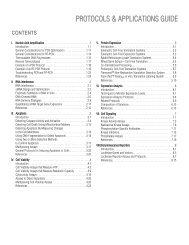2012 Promega catalogue
2012 Promega catalogue
2012 Promega catalogue
Create successful ePaper yourself
Turn your PDF publications into a flip-book with our unique Google optimized e-Paper software.
Life<br />
Science<br />
Catalog<br />
<strong>2012</strong><br />
Worldwide Contact List<br />
Section<br />
Contents<br />
Table of<br />
Contents<br />
Cell Signaling<br />
38<br />
CellTiter-Blue ® Cell Viability Assay<br />
Product Size Cat.# Price ($)<br />
CellTiter-Blue ® Cell Viability Assay 20 ml G8080 196.00<br />
For Research Use Only. Not for Use in Diagnostic Procedures.<br />
100 ml G8081 516.00<br />
10 × 100 ml G8082 Pls. Enq.<br />
Description: The homogeneous CellTiter-Blue ® Cell Viability Assay provides<br />
a fluorescent method for monitoring cell viability. The assay is based on the<br />
ability of living cells to convert a redox dye (resazurin) into a fluorescent end<br />
product (resorufin). Nonviable cells rapidly lose metabolic capacity and thus do<br />
not generate a fluorescent signal. The homogeneous assay procedure involves<br />
adding the single reagent directly to cells cultured in serum-supplemented medium.<br />
After an incubation step, data are recorded using either a plate-reading<br />
fluorometer (preferred) or spectrophotometer.<br />
Features:<br />
• Save Time: The homogeneous, add-incubate-measure format reduces the<br />
number of handling steps.<br />
• Perform More Than One Assay on the Same Sample: The system<br />
can be multiplexed with other assay methods: Apo-ONE ® Homogeneous<br />
Caspase-3/7 Assay or the Caspase-Glo ® Assays for detecting apoptosis.<br />
• Gain Flexibility: The CellTiter-Blue ® Assay delivers excellent Z´ factor<br />
values and offers more flexibility in assay incubation times compared to<br />
other resazurin-based assays.<br />
• Safe: The reagent is generally nontoxic to cells, allowing extended<br />
incubation periods in some situations. Requires no scintillation cocktail,<br />
radioactive waste disposal (unlike [ 3 H]-thymidine incorporation assays) or<br />
hazardous solvents (as required for MTT tetrazolium-based assays).<br />
• Adapt to Your Throughput Needs: The reagent is designed to provide<br />
sufficient volumes for accurate pipetting into 96- or 384-well formats.<br />
Convenient product sizes available for high-throughput screening.<br />
• Automate This Assay: Validated automated methods available at:<br />
www.promega.com/automethods/<br />
• Choose Your Configuration: Learn more about our custom options for<br />
this product at: www.promega.com/myway/<br />
Storage Conditions: Store frozen at –20°C protected from light.<br />
Protocol Part#<br />
CellTiter-Blue ® Cell Viability Assay Technical Bulletin TB317<br />
Fluorescence (560/590nm)<br />
3,000<br />
2,500<br />
2,000<br />
1,500<br />
1,000<br />
500<br />
Apo-ONE ® CellTiter-Blue<br />
Assay<br />
® Assay<br />
0 0<br />
0 40 80120 160<br />
Tamoxifen (µM)<br />
10,000<br />
8,000<br />
6,000<br />
4,000<br />
2,000<br />
Multiplexing cell-based assays. Collecting viability data (CellTiter-<br />
Blue ® Assay) and apoptosis data (Apo-ONE ® Caspase-3/7 Assay) from<br />
the same wells.<br />
Fluorescence (485/527nm)<br />
4128MA05_3A<br />
Cytotoxicity Assays<br />
MultiTox-Glo Multiplex Cytotoxicity Assay<br />
Product Size Cat.# Price ($)<br />
MultiTox-Glo Multiplex Cytotoxicity Assay 10 ml G9270 322.00<br />
5 × 10 ml G9271 1195.00<br />
For Laboratory Use.<br />
2 × 50 ml G9272 1791.00<br />
Description: The MultiTox-Glo Multiplex Cytotoxicity Assay is a sequentialreagent-addition<br />
fluorescent and luminescent assay that measures the relative<br />
number of live and dead cells in cell populations. The MultiTox-Glo Assay sequentially<br />
measures two protease activities; one is a marker of viability, and the<br />
other is a marker of cytotoxicity. The live-cell protease activity is restricted to<br />
intact viable cells and is measured using a fluorogenic, cell-permeant, peptide<br />
substrate (GF-AFC). This substrate enters intact cells, where it is cleaved by the<br />
live cell protease activity to release AFC and generate a fluorescent signal that<br />
is proportional to the number of viable cells. The live-cell protease becomes<br />
inactive upon loss of membrane integrity and leakage into the culture medium.<br />
A second, luminogenic cell-impermeant peptide substrate (AAF-aminoluciferin)<br />
is used to measure dead-cell protease activity, which is released from cells that<br />
have lost membrane integrity. The liberated aminoluciferin product is measured<br />
as “glow type” luminescence generated by Ultra-Glo Recombinant Luciferase<br />
provided in the assay reagent.<br />
The MultiTox-Glo Assay gives ratiometric, inversely correlated measures of<br />
cell viability and cytotoxicity, which correlate with established methods for<br />
measuring viability and cytotoxicity. The ratio of viable cells to dead cells is<br />
independent of cell number and therefore can be used to normalize data.<br />
Having complementary cell viability and cytotoxicity measures reduces errors<br />
associated with pipetting and cell clumping, as well as serving as an internal<br />
control to allow identification of errors resulting from chemical interference<br />
from test compounds or media components.<br />
Features:<br />
• Measure the Number of Live Cells and Dead Cells in Culture:<br />
Sequential-reagent-addition assay with a homogeneous “add-mix-measure”<br />
protocol.<br />
• Normalize Data with a Built-In Internal Control: The ratio of the<br />
number of live cells/number of dead cells is independent of cell number<br />
and can be used to normalize data. This normalization makes results more<br />
comparable well-to-well, plate-to-plate and day-to-day.<br />
• Immediately Identify More False-Positives and False-Negatives:<br />
Independent cell viability and cytotoxicity measurements serve as controls<br />
for each other. If test compounds interfere with one assay chemistry, the<br />
other serves as an internal control.<br />
• Improve your Data: Reduce statistical probability of false-positives (or<br />
false-negatives), and eliminate fluorescence interference issues by luminescence<br />
readout.<br />
Storage Conditions: Store at –20°C, protected from light.<br />
Protocol Part#<br />
MultiTox-Glo Multiplex Cytotoxicity Assay Technical Bulletin TB358<br />
For complete and up-to-date product information visit: www.promega.com/catalog
















